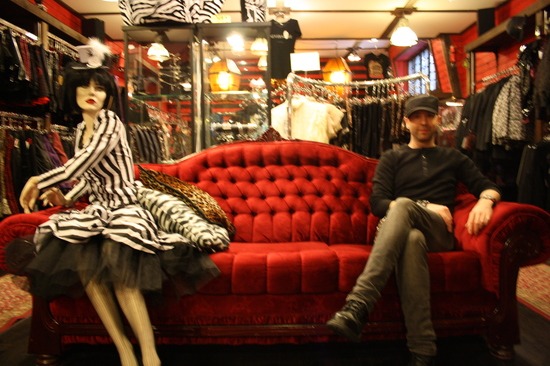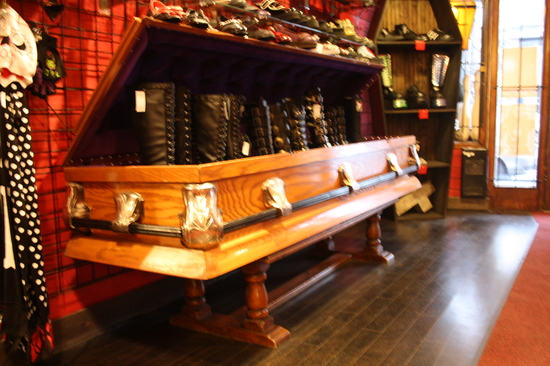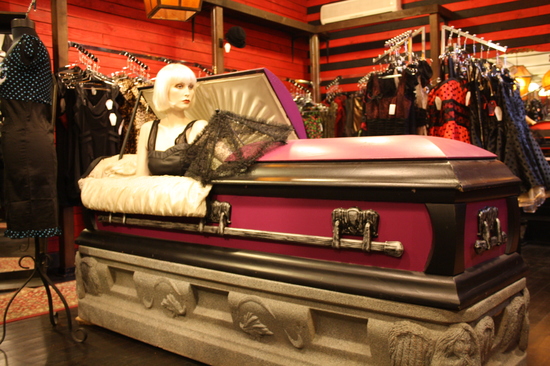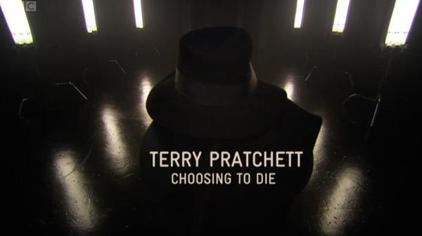March 2013 Archives
Profile of the Freaky
When most people hear the term alternative fashion the mind automatically leaps to thinking it's just freaks who wear too much black. Granted, wearing black does come with the territory of alternative fashion but there is so much more to it. Alternative fashion is a broad term that umbrellas over several subcultures, but for the sake of this article I'll be concentrating on Goth fashion.
Most of today's alternative fashion has its roots in punk, starting in the late 1970s. The punk initiative gave way for other alternative communities such as rockabilly, grunge, and of course Goth. The style without a doubt almost always goes in hand with music. You don't exactly see a bunch of punks at a Justin Bieber concert now do you?
Goths just wear a lot of black and bad makeup. WRONG! You could say the same about widows from the old country; trust me, Nonna is not a Goth. The Goth culture can be defined by several styles: tight clothes, big boots, hair falls, elaborate make-up. (Brill) The only problem describing Goth fashion, like any other sub-culture fashion, it's not a uniform. There is not one set thing to wear to be considered to be part of the Goth community.
One of the more noticeable trends is hyperfeminine clothing, for both genders. According to Dunja Brill in her book "Goth Culture" Gothic men will be seen wearing tighter fitting clothing, growing their hair long and wearing makeup. Though it is referred to as a more androgynous fashion, women a rarely seen in overly-masculine clothing. (Brill) If anything women are highly sexualized; tight revealing clothes and the expectation to be overly feminine. Extreme makeup is not unusually but it is not overly-common. Typical gothic makeup ranges from dark eyeliner and eye shadow to pale foundation and liquid liner designs taking up most of the person's face. (Brill)
The store Cruella, found on Mont Royal Street in Montreal, caters to Montreal's alternative fashion needs. Upon entering their website they tell you that because styles (and their stock) is always changing they only put up part of their collection online. The online collection includes a large selection of corsets, fishnet tops, retro dresses and bondage pants. No, not everything in their collection is black; the corsets and dresses come in a variety of colors.
The stores décor reflects the gothic stylings of the clothing it sells. The shelving and floors are dark, the mannequins are pale and for some reason - it might have something to do with the full sized coffin in the middle of the store - you get the strange feeling of death from the place. Before you go thinking you'll be shopping in the dark, the walls and couch are brightly colored blood red and the chrome fixtures really brighten the place up.
Just as alternative fashion overlaps on mainstream fashion - a black pair of jeans can suit anyone's wardrobe - alternative fashions are not independent of each other. Take retro dresses for example, predominantly seen as a Rockabilly clothing item; it is not unusual to see someone more gothic or punky in style wearing a retro dress. Just as corsets and bondage pants are more than just a gothic clothing items; crowds of people wear corsets and bondage pants to Rocky Horror events and sex conventions.
The alternative fashionista will not usually stick to a style that is strictly goth or strictly punk because there is no such thing. If there were, the average person wouldn't wear a stitch of black. As I mentioned before, the style goes with the music and most people tend to listen to more than just one genre. I, for example, listen to a lot of punk, my fair share of rockabilly and just a bit of metal. My boyfriend will listen to symphonic metal (goth rock), punk and ska. The alternative cultures bleed into each other and so do their fashions. It's not unusual to see a girl at a punk show sporting a gothic corset, a punky studded belt, mainstream skinny jeans and a retro hair style.
Alternative culture is varied and more detail oriented than just a bunch of freaks wearing black. It consists of a collaboration of styles to create something a little out of the ordinary.
Brill, Dunja. Goth Culture: Gender, Sexuality and Style. Oxford: Berg, 2008. Print.
Cruella 63 Mont Royal E Montreal, QC H2T 1N6
I walked into Cruella on Mout Royal street and was instantly surrounded by coffins, coffin décor and a wide array of alternative clothing. I sat down on the luxurious red couch next to Cruella employee of ten years, Joe-Joe. Originally from New Brunswick, Joe-Joe made a trip to Montreal with the intent of shopping at Cruella in 1998 after seeing a documentary featuring the store.
What type of people usually shop at Cruella?
It's quite varied. I'd say half of the people who come shopping here are people that are alternative in some sort of way, the other half is like regular people that you cross anywhere on the street. A lot of people they wouldn't even think they would come and shop in here but sometimes it doesn't necessarily show in their way of dressing. They do enjoy shopping here for a couple of items whether it be jewellery or clothes.
Tell me about the coffins.
There are some that are built as display cases; the ones that are standing up like a bookshelf were made for us quite a while back when the store opened. The two conventional coffins, the one with the boots in the front and the one in the back that serves to put a mannequin in there, those ones are actual real used coffins. Often people take a step back when they hear it's a used coffin. Dead people were exposed in them; people who were to be cremated were exposed in them.
What kind of message do you think the coffins convey?
We like to have a macabre feeling, that's a theme in the store. It's also to de-naturalize the coffins; it makes it kind of funny to use a coffin to display shoes. We play with macabre to show people there's nothing to be afraid of. We don't adore coffins or sleep in them; it's a fun prop because it's unnatural.
 How has the store evolved since it first opened in 1996?
How has the store evolved since it first opened in 1996?
Absolutely, the store actually started as a thrift store, so it was only used and revamped clothing and shoes for the first year or two. Then some local designers started popping up, and were giving us the option of creating some clothing that were appropriate for the genre the owners were looking for, which turns out to be a lot easier than going around to other thrift sho
ps and garage sales to find clothes that suit the gothic genre. After a while the owners spotted a couple of companies were sprouting around the world and some companies that were already existing that had gothic jewellery and gothic clothes that we started ordering and importing stuff from various company. Now we don't have anything that is used, everything is new; it's about 70% imports 30% locally made.
How does Cruella keep up to date with alternative fashion?
Alternative culture has little waves but
it's never trends like popular culture. In popular culture you'll have trends that come and go from one season to the next. In alternative culture you have little currents that come and go but never completely go. You can dress like in the 1990s or 1980s and it's still very acceptable in alternative culture. Trends are just added to this snowball effect so it just keeps growing. You have new trends that come into the mix but the old ones never disappear. The way we've been keeping up with it by just seeing the public, the internet and underground magazines that talk about trends and style and what's upcoming. We've grown quite a bit, the store was just gothic clothing, it wasn't long before we started incorporating many other genres of sub-culture; whether it be psycho-billy, cyber-punk, Lolita, steam-punk.
Do think trends differ in Montreal than say Toronto or Vancouver?
There is definitely a global alternative current, especially now with the internet. There is a global alternative culture that is stronger than before. The internet is a place where people part of an alternative culture go to get their things since if you're from a smaller town than Montreal chances are there is barely any alternative community at all. So the only place to find that community is online.
From one city to the next the currents are different. Sometime there are delays; some cities are more avant-garde than others. Some cities have a bigger psycho-billy trend; some cities have more of a cyber-punk or black metal trend. It really varies from one city to the next.
How do you react to people who think alternative fashion is just wearing a lot of black?
lot of black?
Well, I'd say, the wearing a lot of black, is more focused on the gothic genre more than the other genres. It's a lot more than that; people look at things on the surface. And on the surface, the first thing that pops in your head when you see a group of people that are Goth is that they're all dressed in black, that they have no imagination, they just dress in black. You can't just see the clothes for the color, if you start looking at the designs you start noticing that these people are actually very creative. They are varied in the way that they dress. It just so happens that the clothes are black. As soon as the item isn't black anymore, it's not gothic anymore in the eyes of many people and they'll see the design of it more than the color. The color black seems to have a stronger energy than the design of the item.
What would you say to people who are afraid or intimidated to come into the store?
Don't be afraid! A lot of people that aren't alternative come in here and right away feel intimidated and they let us know that they're just here to look around, that they don't want to buy anything and then I tell them, there's no problem. They'll say, "I know I don't look like one of your customers." But then I'll tell them, "You do look like one of my costumers." We definitely have to be nicer and more approachable than sales people in other stores. That's something that has to be very well respected by any employee that we hire because a lot of people will come in here with that prejudice that we're going to be mean, we're going to be kind of gloomy and that we don't want people not dressed in black coming here. Which is completely ridiculous, right away we try to make them feel right at home and it doesn't matter if you're not dressed in black, I mean half of our customers are not dressed in black or don't even know what gothic is but they're still very welcome here and that's half of our clientele.
Why do you think Cruella has stood the test of time?
We have a lot of selection, we've been here for a very long time, we're well known name, we're one of the oldest pillars of alternative culture in Montreal. So we think whenever people look for something that is very funky alternative Cruella is probably the first places that come to mind for that. And well choosing our products carefully I guess.

Terry Pratchett, a world renowned fantasy writer and satirist, has a personal dilemma. He has been diagnosed with Alzheimer's and is slowly losing his clarity. His biggest fear is losing the ability to communicate, write, imagine -all the skills required for a writer to continue his work. But living in the UK, he knows assisted suicide is as illegal as it is controversial. Thus, his quest into the forbidden world of voluntary death begins, well outside his home and comfort zone.
"Choosing to Die" (2011) follows Pratchett both on the street and in his own private life, as he interviews those who have decided, essentially, to end a life they find too miserable to continue. This quest takes him to Switzerland, where he gets to the bottom of Dignitas (an assisted suicide organization) and even witnesses an assisted death.
The cinematography is simple, straightforward and real. This simplicity contrasts and complements the gravity of the subject. We get an uncensored look at a controversial, hard-to-look-at subject. It is done in two parts: interviews with the subjects, and then an introspective one-on-one with Pratchett. Whether we turn away uncomfortable or remain glued to the screen, we are faced with his dilemma and the questions that the film raises. Throughout the movie we, the viewers, are Pratchett's impartial accomplices.
Death: the word alone is heavy with connotation, imagery, and memories. Death, just like the grim responsibility of becoming older and wiser, is unavoidable. While it happens you can't help but be smack down in the middle. When it's done and over with, you may supress it or deal with it as best you are able. Then, you are free to forget it (if you can), until it rears its ugly head again.
Many of us evade the subject for one reason or another, until we're too helpless to escape it. We don't talk about death, until it's is absolutely necessary.
"I think talking about death, thinking about death, is a reminder of our own mortality. So when you're talking about it you're reminding yourself that one day you too will die, and that's not something you want to think about, because it's a scary thought."
"There is no expiry date on grief. Know that it will take you time to find yourself again. Dealing with grief is a journey; you won't know how much time it will take you to complete it, where it will take you and what kind of person you will be at the end of it, just know that you don't have to travel alone."
Death, they say, is the only certain thing in life. Eventually all of us will deal with it in one way or another, and this is a generalization that is absolutely true. Children will often lose their elderly parents, accidents will rob parents of their children, and natural disasters and diseases will separate couples and rupture families. It's a grim subject no one likes to think or talk about, but that is precisely why none of us is ever prepared to face it. This instructional article outlines what experienced grief counsellors advice those that have experienced the death of a loved one, and it may help you deal with the grief you are experiencing.
So, death. People don't like talking about death, why do you think that is?
Because when we talk about death it reminds us of our own mortality, that we're going to die one day. It's a certainty we face from the day we're born, and the more we're reminded of death, the more uncomfortable we become. I think for most people death is something we don't want to experience or see it face to face, so when we talk about it, we're bringing ourselves that much closer to it, and that's something your average person simply doesn't want. It's an unnerving feeling.
by Ally Mutsmakher
Montreal is a place that's buzzing with life. It boasts an interesting hybrid of Anglo-French culture and offers a remarkable account of Canadian history. Taking a stroll in the crisp winter weather, I can still feel the history coursing through the veins of monumental buildings in Old Montreal. I'm reminded that in the in 19th century Montreal was considered the height of Canadian culture, equality and economic prosperity, and that for many writers, poets and actors Montreal was the obvious choice to set their roots and let their creative legacy unfurl.
Aside from the obvious remnants of culture that can still be found in the city's architecture, history hides in the unlikeliest places. In fact, the Mount Royal and Notre Dame des Neiges Cemeteries include the tombstones of many accomplished Montreal writers, actors, musicians, painters, hockey players and politicians.
Seems like a morbid activity for a cold Montreal day? Not at all. Cemeteries have long been the setting for unconventional romantic dates, a place where artists get inspired by their dearly departed mentors, and a concentration of a city's history where tourists can discover the secret lives people have led decades ago.
Since I sympathise with your curiosity I've decided to divulge these secrets, from beyond the grave, without compromising your physical warmth. You can remain under heavy covers, armed with a hot chocolate and read on the spooky/ odd/ amusing tales of famous, notorious and interesting dead Montrealers.